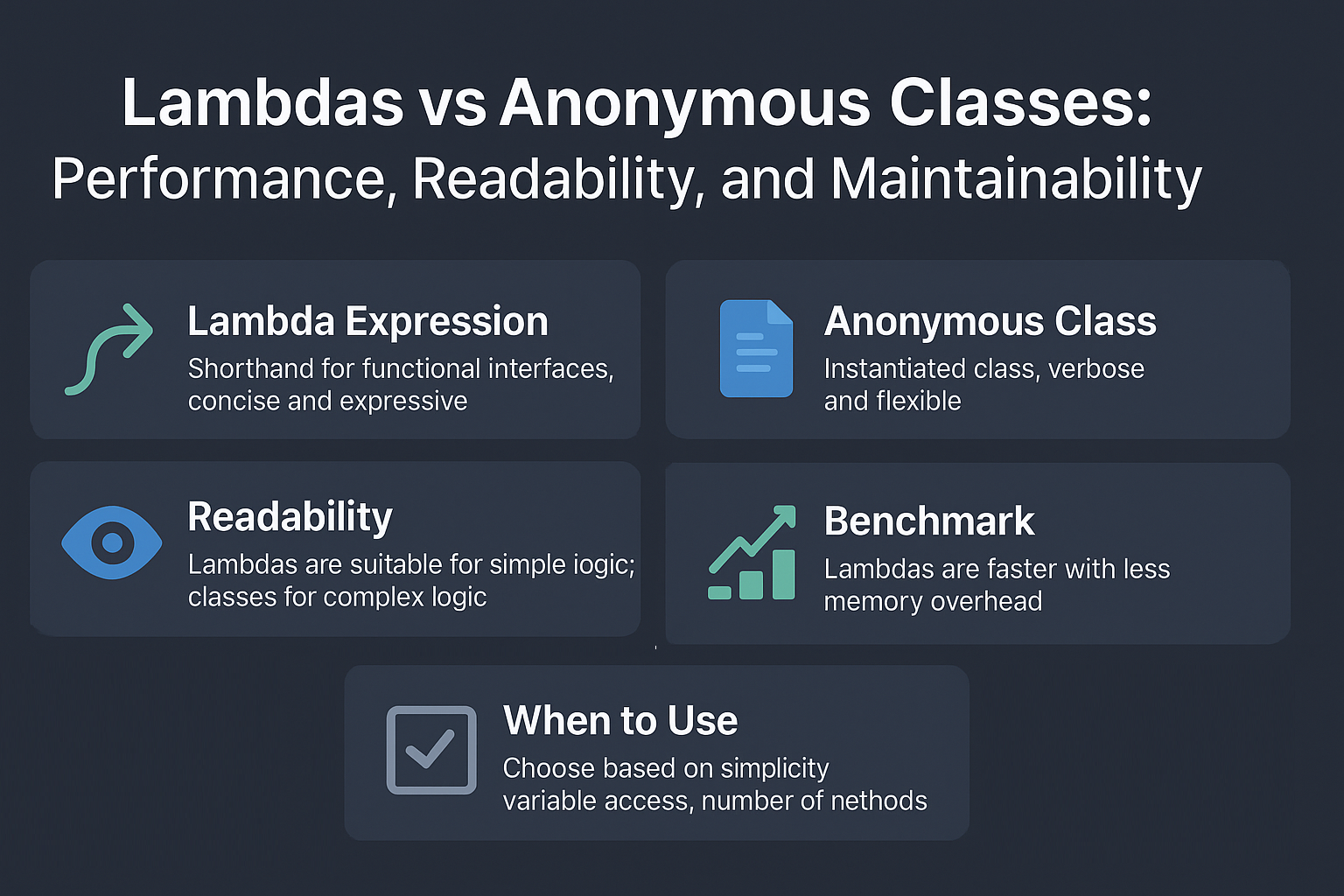Java developers often find themselves choosing between lambda expressions and anonymous classes when implementing interfaces with a single method. While both approaches aim to reduce boilerplate and improve code clarity, they differ significantly in performance, readability, and maintainability. This tutorial explores these differences with practical examples and deep technical insights.
🔍 Introduction
In modern Java, lambdas have become the go-to solution for functional programming. However, anonymous inner classes, introduced in Java 1.1, still persist in many codebases.
So the question arises:
💭 Should you replace anonymous classes with lambdas? Is it always better in terms of performance, readability, and long-term maintenance?
Let’s dive deep into the core differences, use cases, and pros and cons of both.
🧠 Understanding the Basics
✅ What is a Lambda Expression?
A lambda is a shorthand syntax for implementing functional interfaces. It simplifies instances where we need to pass behavior (functions) instead of objects.
Runnable task = () -> System.out.println("Running in a lambda!");
🧱 What is an Anonymous Class?
An anonymous class is a class declared and instantiated in a single statement, usually for short-lived purposes.
Runnable task = new Runnable() {
@Override
public void run() {
System.out.println("Running in an anonymous class!");
}
};
💡 Key Differences
| Feature | Lambda Expression | Anonymous Class |
|---|---|---|
| Syntax | Concise | Verbose |
| Target | Functional Interface | Any class/interface |
this keyword |
Refers to enclosing class | Refers to anonymous class |
| Capturing variables | Must be effectively final | Can access final and non-final |
| Bytecode generation | Invokedynamic (Java 8+) | Creates a separate class file |
| Readability | High | Low (due to verbosity) |
| Performance | Higher (after JDK 8+) | Slower (more memory overhead) |
🛠️ Java Syntax and Interface Structure
Lambda expressions only work with functional interfaces — interfaces with a single abstract method.
Examples:
RunnableCallable<T>Function<T, R>Predicate<T>Consumer<T>
Consumer<String> printer = s -> System.out.println(s.toUpperCase());
With anonymous class:
Consumer<String> printer = new Consumer<>() {
@Override
public void accept(String s) {
System.out.println(s.toUpperCase());
}
};
⚙️ Performance Comparison
🔬 Bytecode Analysis
- Lambda: Uses
invokedynamicand generates bytecode dynamically. - Anonymous Class: Compiled into a separate
.classfile and loaded individually.
🧪 Benchmark (Using JMH)
@Benchmark
public void runWithLambda() {
Runnable task = () -> {};
task.run();
}
@Benchmark
public void runWithAnonymousClass() {
Runnable task = new Runnable() {
@Override
public void run() {}
};
task.run();
}
Result: Lambda is generally faster and has lower memory overhead.
🔍 Readability and Maintainability
✅ Lambdas Shine When:
- The logic is short and simple.
- The developer is familiar with functional programming.
⚠️ Anonymous Classes Are Better When:
- Overriding multiple methods.
- Need access to non-final variables.
- Require more complex logic with state.
🤝 Integration with Streams & Collections
List<String> names = List.of("alice", "bob", "charlie");
names.stream()
.filter(name -> name.startsWith("a"))
.map(String::toUpperCase)
.forEach(System.out::println);
This fluent functional pipeline would be cumbersome with anonymous classes.
⚠️ Common Pitfalls and Anti-Patterns
- Overusing lambdas for complex business logic.
- Excessive chaining leads to unreadable code.
- Using lambdas where side-effects dominate (not recommended).
🧩 Functional Patterns
Command Pattern with Lambda
interface Command {
void execute();
}
Command print = () -> System.out.println("Executed!");
📌 What's New in Java 8, 11, 17, and 21?
- Java 8: Lambdas, Streams, java.util.function, default methods.
- Java 9:
Optional.ifPresentOrElse,Flow API. - Java 11:
varallowed in lambda parameters. - Java 21: Virtual threads, scoped values, structured concurrency — all work seamlessly with lambdas.
✅ Conclusion and Key Takeaways
- Use lambdas for clean, expressive, and performant code when implementing functional interfaces.
- Prefer anonymous classes for more complex, stateful implementations or when working with legacy code.
- Modern Java encourages lambdas — especially in APIs using streams and callbacks.
❓ Expert-Level FAQ
1. Can I use lambdas for exception handling?
Yes, but you need to wrap checked exceptions explicitly or use utility methods.
2. What’s the difference between Consumer and Function?
Consumer accepts an input and returns nothing; Function returns a result.
3. Are lambdas serializable?
Only if the target interface extends Serializable.
4. How are lambdas garbage collected?
They are garbage collected like regular objects if no references are held.
5. Can I assign a lambda to a variable?
Yes, if the target is a functional interface.
6. Can lambdas reference this?
Yes, but this refers to the enclosing class, not the lambda.
7. Do lambdas support default methods?
They implement abstract methods; default methods can be inherited.
8. Are method references better than lambdas?
Use them when they enhance readability; otherwise, lambdas are clearer.
9. Do lambdas support recursion?
Only indirectly through helper methods or custom interfaces.
10. Are lambdas always better than anonymous classes?
No — use lambdas when the use-case is simple and functional.
